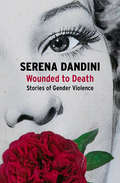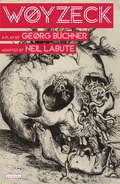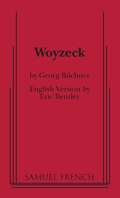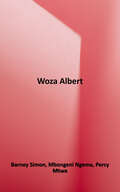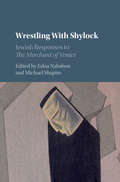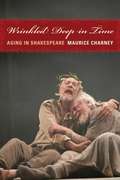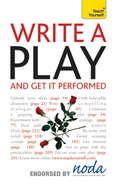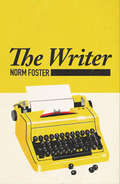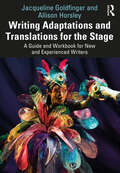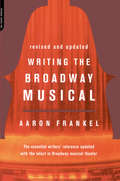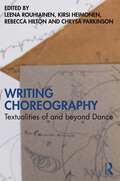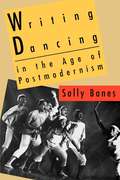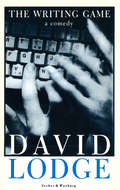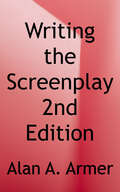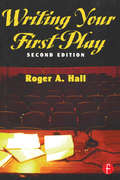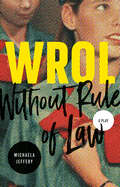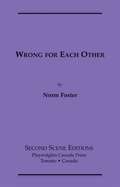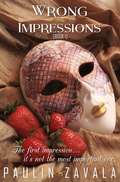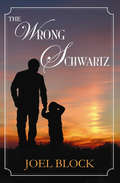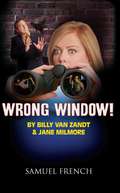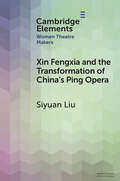- Table View
- List View
Wounded to Death
by Serena DandiniThe voices too many women have lost; the dreams too many men have destroyed In these monologues originally written for theatrical performance, women who were victims of murder regain their voices to tell their truths. One woman, her body unceremoniously dumped in a well by her husband, laments the police force's halfhearted investigation of her murder. Another, forced to toil ceaselessly for a meager few euros per month, grows weary of enduring daily beatings and attempted rape and hangs herself from a crystal chandelier. Inspired by true events, these monologues represent what the victims of femicide might say, had they not been robbed of their voices. First staged as a play in 2012 in Palermo, Italy, Wounded to Death has taken Italy and the world by storm. Alongside the powerfully imagined speeches in this edition, Serena Dandini presents the grim global statistics of violence against women. This essential book showcases the author's exceptional capacity for creating nuanced emotion, from comic to painful, from grotesque to dramatic. With a factual basis and cinematic flair, these works compel the reader to consider the violence that is taking place right now all over the world.
Woyzeck: A Play
by Neil LabuteGeorg Büchner's unfinished play about the poor soldier Woyzeck, subject of a medical experiment and tormented by hallucinations from a diet of only peas. Georg Büchner's unfinished play about the poor soldier Woyzeck, subject of a medical experiment and tormented by hallucinations from a diet of only peas. His girlfriend, Marie, by whom he's fathered a child; Marie's overpowering desire for the alluring Drum- Major; and the murderous outcome of this oppressive admixture of circumstances is without a doubt one of the bleakest works of world literature. It is also considered by many to mark the beginning of modern drama. In this powerful adaption, Neil LaBute embraces the glittering darkness of Woyzeck's violent, erotic, inhumane world and uncompromisingly makes it his own. From his opening in an operating theatre and then scene by macabre scene, LaBute imbues this classic with his singular intensity and moral vision, as he takes it to its nightmarish conclusion. Included in this volume is Neil LaBute's provocative new monologue "Kandahar," in which a soldier back from Afghanistan calmly explains his devastating actions of the day before. A gripping stand-alone piece, this short work is also a trenchant modern-day exploration of the potent and enduring themes of Woyzeck.
Woyzeck (Bentley)
by Eric Bentley Georg BüchnerDrama / Characters: 14 male, 4 female Sacrificed to powers larger than himself, Woyzeck is one of drama's first anti-heroes. He serves a German captain and makes money by allowing a doctor to experiment on him, but his deeper morality leads him to a tragic end.
Woza Albert (Modern Plays)
by Percy Mtwa Mbongeni Ngema Barney SimonWoza Albert! is based on one dazzlingly simple idea - that the Second Coming of Jesus Christ should take place in present-day South Africa. This brilliant two-man show from the Market Theatre, Johannesburg, took the Edinburgh Festival then London by storm in September 1982, playing to standing ovations every night. It was also seen in Berlin, Los Angeles, San Francisco, Seattle, and Philadelphia, and twice on BBC TV.
Wrestling With Shylock
by Edna Nahshon Michael ShapiroShakespeare's The Merchant of Venice occupies a unique place in world culture. As the fictional, albeit iconic, character of Shylock has been interpreted as exotic outsider, social pariah, melodramatic villain and tragic victim, the play, which has been performed and read in dozens of languages, has served as a lens for examining ideas and images of the Jew at various historical moments. In the last two hundred years, many of the play's stage interpreters, spectators, readers and adapters have themselves been Jews, whose responses are often embedded in literary, theatrical and musical works. This volume examines the ever-expanding body of Jewish responses to Shakespeare's most Jewishly relevant play.
Wrinkled Deep in Time: Aging in Shakespeare
by Maurice CharneyShakespeare was acutely aware of our intimate struggles with aging. His dramatic characters either prosper or suffer according to their relationship with maturity, and his sonnets eloquently explore time's ravaging effects. "Wrinkled deep in time" is how the queen describes herself in Antony and Cleopatra, and at the end of King Lear, there is a tragic sense that both the king and Gloucester have acquired a wisdom they otherwise lacked at the beginning of the play. Even Juliet matures considerably before she drinks Friar Lawrence's potion, and Macbeth and his wife prematurely grow old from their murderous schemes.Drawing on historical documents and the dramatist's own complex depictions, Maurice Charney conducts an original investigation into patterns of aging in Shakespeare, exploring the fulfillment or distress of Shakespeare's characters in combination with their mental and physical decline. Comparing the characterizations of elderly kings and queens, older lovers, patriarchal men, matriarchal women, and the senex-the stereotypical old man of Roman comedy-with the history of life expectancy in Shakespeare's England, Charney uncovers similarities and differences between our contemporary attitudes toward aging and aging as it was understood more than four hundred years ago. From this dynamic examination, a new perspective on Shakespeare emerges, one that celebrates and deepens our knowledge of his subtler themes and characters.
Write A Play And Get It Performed: Teach Yourself
by Lesley Bown Lesley Hudswell Ann GawthorpeWrite a Play - and Get It Performed is designed for would-be writers of every level and for all types of motivation by two prize-winning professionals. Whether writing for the specific needs of an amateur drama group, community event, political campaign or simply for personal or professional development, this is a guide to the craft of playwriting. It offers guidance on the creative principles of scripts, characters, plot, structure and dialogue and explains the principles of staging and stage directions as well as gives tips on how to write for a variety of different situations, for every age and ability and according to specific genres - particularly those often preferred by amateur groups, such as pantomime and musical theatre.NOT GOT MUCH TIME?One, five and ten-minute introductions to key principles to get you started.AUTHOR INSIGHTSLots of instant help with common problems and quick tips for success, based on the author's many years of experience.TEST YOURSELFTests in the book and online to keep track of your progress.EXTEND YOUR KNOWLEDGEExtra online articles at www.teachyourself.com to give you a richer understanding of writing a play.FIVE THINGS TO REMEMBERQuick refreshers to help you remember the key facts.TRY THISInnovative exercises illustrate what you've learnt and how to use it.
The Writer
by Norm FosterDonald Wellner knew success when he wrote a hit play thirty-five years ago, but now he’s recently separated, living in a small apartment, and promising that he’s trying to start a new script. His fortysomething son Blake is a travel writer with commitment issues who pops by between trips to try to hold his family together and prove his worth. Over seven years, Donald experiences the onset of dementia, and father and son become both closer and farther apart. This story of familial bonds provides delightfully comical and satisfyingly sentimental clarity in those small moments that will last forever.
Writing Adaptations and Translations for the Stage: A Guide and Workbook for New and Experienced Writers
by Jacqueline Goldfinger Allison HorsleyWriting Adaptations and Translations for the Stage is a practical guide for writing adapted works for theatrical performance. Broadway translator and dramaturg Allison Horsley and award-winning playwright and educator Jacqueline Goldfinger take readers step-by-step through the brainstorming, writing, revision, and performance processes for translations and adaptations. The book includes lectures, case studies, writing exercises, and advice from top theater professionals on the process of creating, pitching, and producing adaptations and translations, covering a wide range of topics such as jukebox musicals, Shakespeare adaptations, plays from novels, theater for young adults, and theater in translation and using Indigenous language. Artists who share their wisdom in this book include: Des McAnuff (Tony Award), Emily Mann (Tony Award), Dominique Morisseau (Broadway Adaptor, Tony Award nominee, MacArthur Genius Fellow), Lisa Peterson (Obie Award, Lortel Award), Sarah Ruhl (Broadway Playwright, Tony Award nominee, Pulitzer Prize finalist, MacArthur Genius Fellow), and Tina Satter (Broadway Director, Obie Award, Guggenheim Fellowship). The book also features interviews with artists working both in the US and internationally, as well as guest columns from artists who work in less traditional adaptive forms including cabaret, burlesque, opera, community-engaged process, and commercial theater. Writing Adaptations and Translations for the Stage is an essential resource for students and instructors of Dramatic Writing, Playwriting, and Creative Writing courses and for aspiring playwrights.
Writing Adaptations and Translations for the Stage: A Guide and Workbook for New and Experienced Writers
by Jacqueline Goldfinger Allison HorsleyWriting Adaptations and Translations for the Stage is a practical guide for writing adapted works for theatrical performance.Broadway translator and dramaturg Allison Horsley and award-winning playwright and educator Jacqueline Goldfinger take readers step-by-step through the brainstorming, writing, revision, and performance processes for translations and adaptations. The book includes lectures, case studies, writing exercises, and advice from top theater professionals on the process of creating, pitching, and producing adaptations and translations, covering a wide range of topics such as jukebox musicals, Shakespeare adaptations, plays from novels, theater for young adults, and theater in translation and using Indigenous language. Artists who share their wisdom in this book include: Des McAnuff (Tony Award), Emily Mann (Tony Award), Dominique Morisseau (Broadway Adaptor, Tony Award nominee, MacArthur Genius Fellow), Lisa Peterson (Obie Award, Lortel Award), Sarah Ruhl (Broadway Playwright, Tony Award nominee, Pulitzer Prize finalist, MacArthur Genius Fellow), and Tina Satter (Broadway Director, Obie Award, Guggenheim Fellowship). The book also features interviews with artists working both in the US and internationally, as well as guest columns from artists who work in less traditional adaptive forms including cabaret, burlesque, opera, community-engaged process, and commercial theater.Writing Adaptations and Translations for the Stage is an essential resource for students and instructors of Dramatic Writing, Playwriting, and Creative Writing courses and for aspiring playwrights.
Writing The Broadway Musical
by Aaron FrankelBrimming with advice and techniques, this essential reference for book- and songwriters clearly explains the fundamentals of the three crafts of a musical-book, music, and lyrics. Using copious examples from classic shows, Frankel has created the quintessential musical writers' how-to. Among the topics:definitions of musical theater; differences between musical books and straight plays and between poetry and lyrics; what a score is and how it develops; how to write for the voice; and how to audition musicals for producers. With a new introduction and revised text, Frankel's work is ready to guide a new generation of aspiring writers.
Writing Choreography: Textualities of and beyond Dance
by Leena Rouhiainen Kirsi Heimonen Rebecca Hilton Chrysa ParkinsonA new contribution to studies in choreography, Writing Choreography: Textualities of and beyond Dance focuses upon language and writing-based approaches to choreographing from the perspectives of artists and researchers active in the Nordic and Oceanic contexts.Through the contributions of 15 dance–artists, choreographers, dramaturges, writers, interdisciplinary artists and artist–researchers, the volume highlights diverse textual choreographic processes and outcomes arguing for their relevance to present-day practices of expanded choreography. The anthology introduces some Western trends related to utilizing writing, text and language in choreographic processes. In its focus on art-making processes, it likewise offers insight into how performance can be transcribed into writing, how practices of writing choreograph and how choreography can be a process of writing with. Readers, such as dancers, choreographers, students in higher education of these fields as well as researchers in choreography, gain understanding about different experimental forms of writing forwarded by diverse choreographers and how writing is the motional organisation of images, signs, words and texts. The volume presents a new strand in expanded choreography and acts as inspiration for its continued evolution that engenders new adaptations between language, writing and choreography.Ideal for students, scholars and researchers of choreography and dance studies.
Writing Dancing in the Age of Postmodernism
by Sally BanesDrawing of the postmodern perspective and concerns that informed her groundbreaking Terpsichore in Sneakers, Sally Banes's Writing Dancing documents the background and developments of avant-garde and popular dance, analyzing individual artists, performances, and entire dance movements. With a sure grasp of shifting cultural dynamics, Banes shows how postmodern dance is integrally connected to other oppositional, often marginalized strands of dance culture, and considers how certain kinds of dance move from the margins to the mainstream.Banes begins by considering the act of dance criticism itself, exploring its modes, methods, and underlying assumptions, and examining the work of other critics. She traces the development of contemporary dance from the early work of such influential figures as Merce Cunningham and George Balanchine to such contemporary choreographers as Molissa Fenley, Karole Armitage, and Michael Clark. She analyzes the contributions of the Judson Dance Theatre and the Workers' Dance League, the emergence of Latin postmodern dance in New York, and the impact of black jazz in Russia. In addition, Banes explores such untraditional performance modes as breakdancing and the "drunk dancing" of Fred Astaire.Ebook Edition Note: Ebook edition note: All images have been redacted.
Writing Game: A Comedy
by David LodgeDavid Lodge’s first full-length play examines that curious fixture in the writing game where the amateurs meet the professionals – on a course in creative writing. Maude, author of nine bestsellers, and Simon, with one sensational success to his name, are veterans of this particular course: Leo, a campus-based American novelist astounded by the dilettante approach of the English, is the odd man out.The idea is to put the students under pressure, but in the converted barn that houses the tutors, professional and sexual tensions, past slights and current rivalries rapidly build to a fierce head of steam. Out of these pressures, David Lodge distils a sharply observed comedy of the problems and preoccupations of the writer as the professionals, striving to explain to enthusiastic beginners how to do it, are forced to confront an altogether trickier question: why on earth do they themselves write in the first place? Delicately probing, nimbly parodic, uncomfortably on target, Lodge’s incisive study of writers at work and at odds will bring the pleasure of recognition to all readers of fiction – and to most of those in the game.
Writing the History of the British Stage, 1660–1900
by Richard SchochThis is the first book on British theatre historiography. It traces the practice of theatre history from its origins in the Restoration to its emergence as an academic discipline in the early twentieth century. In this compelling revisionist study, Richard Schoch reclaims the deep history of British theatre history, valorizing the usually overlooked scholarship undertaken by antiquarians, booksellers, bibliographers, journalists and theatrical insiders, none of whom considered themselves to be professional historians. Drawing together deep archival research, close readings of historical texts from the seventeenth, eighteenth and nineteenth centuries, and an awareness of contemporary debates about disciplinary practice, Schoch overturns received interpretations of British theatre historiography and shows that the practice - and the diverse practitioners - of theatre history were far more complicated and far more sophisticated than we had realised. His book is a landmark contribution to how theatre historians today can understand their own history.
Writing the Monarch in Jacobean England
by Jane RickardKing James VI and I's extensive publications and the responses they met played a key role in the literary culture of Jacobean England. This book is the first sustained study of how James's subjects commented upon, appropriated and reworked these royal writings. Jane Rickard highlights the vitality of such responses across genres - including poetry, court masque, sermon, polemic and drama - and in the different media of performance, manuscript and print. The book focuses in particular on Jonson, Donne and Shakespeare, arguing that these major authors responded in illuminatingly contrasting ways to James's claims as an author-king, made especially creative uses of the opportunities that his publications afforded and helped to inspire some of what the King in turn wrote. Their literary responses reveal that royal writing enabled a significant reimagining of the relationship between ruler and ruled. This volume will interest researchers and advanced students of Renaissance literature and history.
Writing the Screenplay: TV and Film
by Alan A. ArmerIn this new edition, Emmy - Award winner Alan Armer takes aspiring writers through the essential steps needed to create successful dramatic scripts for TV and Film: visual thinking characters and plotting, story structure and conflict, dialog, and formats.
Writing Your First Play
by Roger HallWriting Your First Play provides the beginning playwright with the tools and motivation to tell a story through dramatic form. Based in a series of exercises which gradually grow more complex, the books helps the reader to understand the basic elements of drama, conflict, and action. The exercises help the reader to become increasingly sophisticated in the use of dramatic formats, turning simple ideas into a viable play. Topics include: the role of action in drama;developing action and conflict to reveal character;writing powerful and persuasive dialog;writing from personal experience:pros and cons;how to begin the story and develop the storyline. This new edition is thoroughly updated and contains new examples based on contemporary plays. The author has added additional writing exercises and a new student-written one act play. It also contains a new chapter on how to sell your play once it is written.With examples based on student work, this text both inspires and educates the student and fledgling playwright, providing solid tools and techniques for the craft of writing a drama. Roger A. Hall, a professor of theatre at James Madison University, had taught playwriting for nearly 20 years. Many of his students have gone on to write for theatre, television, and the screen. He has written numerous plays and articles and has acted and directed extensively in the theatre.
Written Voices, Spoken Signs: Tradition, Performance, and the Epic Text (Center for Hellenic Studies Colloquia #1)
by Egbert Bakker and Ahuvia KahaneWritten Voices, Spoken Signs is a stimulating introduction to new perspectives on Homer and other traditional epics. Taking advantage of recent research on language and social exchange, the nine essays in this volume focus on performance and audience reception of oral poetry. These innovative essays by leading scholars of Homer, oral poetics, and epic invite us to rethink some key concepts for an understanding of traditional epic poetry. Egbert Bakker examines the epic performer's use of time and tense in recounting a past that is alive. Tackling the question of full-length performance of the monumental Iliad, Andrew Ford considers the extent to which the work was perceived as a coherent whole in the archaic age. John Miles Foley addresses questions about spoken signs and the process of reference in epic discourse, and Ahuvia Kahane studies rhythm as a semantic factor in the Homeric performance. Richard Martin suggests a new range of performance functions for the Homeric simile. And Gregory Nagy establishes the importance of one feature of epic language, the ellipsis. These six essays centered on Homer engage with fundamental issues that are addressed by three essays primarily concerned with medieval epic: those by Franz Bäuml on the concept of fact; by Wulf Oesterreicher on types of orality; and by Ursula Schaefer on written and spoken media. In their Introduction the editors highlight the underlying approach and viewpoints of this collaborative volume.
WROL (Without Rule of Law)
by Michaela JefferyConvinced the world at large can’t be trusted to prioritize the well-being of adolescent girls in the event of a cataclysmic event (or just in general), a determined troupe of preteen “doomers” commit to preparing for survival in the post-collapse society they anticipate inheriting. When Maureen, Jo, Sarah, Vic, and Robbie sneak out at night to investigate an ominous hidden lair in the woods, they believe they have stumbled onto proof of what happened to a mysterious local cult that vanished over a decade ago. As they search for vital clues, examining small bones and dusty cans of food for signs of life, they fight to be understood in a world that seems to reject them. What they discover changes everything—eighth grade will never be the same. Part Judy Blume, part Rambo, this darkly comic coming-of-age story for complicated times is for any young woman who has ever been told that she is “too much,” or that what she fears is illegitimate, or that what she has to say is less important than keeping the peace.
Wrong For Each Other
by Norm FosterA chance meeting in a restaurant, after four years apart, sends a couple flashing back through the highs and lows of their courtship and marriage. It is an hilarious and often heart-breaking look at the rollercoaster ride of a relationship."A tasty comic treat. Characters with whom we can all identify." —London Free Press"Very funny… a charming two-hander." —Globe and Mail
Wrong Impressions [Book I]
by Paulin Zavala Alejandra Mendoza ZacaríasHow much can it affect to want to meet someone? Idealization to a person is powerful and unpredictable. Will he be able to fulfill the expectations, which for years has been created on the girl? Allan Estrada is a man who had just lost his parents, he thought he would never be able to trust anyone, he had been in charge of a millionaire company and he had no idea how to handle it. His luck changed when he met Antonio, who supported him and helped him out of the shadows, and when he began to tell him about his youngest daughter, he was interested in meeting the girl. Only she did not make it easy.
The Wrong Schwartz
by Joel BlockIt might have been just another messy marital triangle with routine melodrama: the stale marriage, the affair--his and hers--and the recriminations. But volatile passions intersected in a manner not unlike the coupling of an explosive and a detonator. Mark Shapiro is a handsome, enormously successful cardiac surgeon with a loving wife, an adoring son, plenty of money and a nightmare in the making. As successful as he is, he hungers for more notoriety and is drawn into believing a mysterious and alluring woman he has met will bring it to him. He also hungers for her. It is an out-of-control type of appetite, nothing short of sexual obsession. All marriages have ups and downs, but when Mark learns who "Mr. Tuesday" is, his wife's lover, his rage is not diminished by his own affair. One night, still irresistibly drawn to the other woman--whose promise has turned to horror--he learns more than he ever wanted to know about the palpable dangers of ambition.
Wrong Window!
by Jane Milmore Billy Van ZandtComedy Thriller / Characters: 5m, 3f / Set: InteriorVan Zandt & Milmore pay tribute to Master of Horror Alfred Hitchcock, with this comedy whodunit. Off-and-on New York couple Marnie and Jeff enter an even more complicated phase of their relationship when they think they spy their cross-courtyard neighbor do away with his wife. After they draw their torn curtain, the lady vanishes, and suspicion places murder beyond a shadow of a doubt. The bumbling witnesses sneak into their neighbor's apartment - 39 steps away - and the fun begins. Among multiple door-slammings, body-snatchings, and a frantic flashlight chase scene, two questions remain: Who killed Lila Larswald? And... if she's not dead...then who is? The crazy farce plays out on a shadow-box set that allows the audience to be present in one apartment, while viewing the action in its mirror-image neighboring unit across the way. "Take the money and run to this window before it closes!" Two River Times. "If you're a fan of Rear Window on screen, you'll award Wrong Window on stage a perfect 10. A barrage of gag-filled dialogue. Knee-slappingly funny from start to finish! Take the money and run to this window before it closes!" -Philip Dorian, Two River Times
Xin Fengxia and the Transformation of China's Ping Opera
by Siyuan LiuThis Element focuses on Xin Fengxia (1927–1998), a star of the regional xiqu form pingju, and her prominent role in transforming the genre from folk entertainment for the lower class to one of the most notable winners of the xiqu reform after the establishment of the People's Republic of China (PRC) in 1949. The Element's four sections expand from this core concept to include the four stages of her life experience and artistry that shaped her legacy: growing up in China's third largest theatre market Tianjin before 1949, national stardom in Beijing (1949–1957), restricted creativity amidst political upheavals (1957–1975), and as a prominent author after a stroke (1977–1998). Rather than following a biographical approach, these sections zero in on the environment before and after 1949 that made her a prominent pingju reformer and the consequent price of such success.
